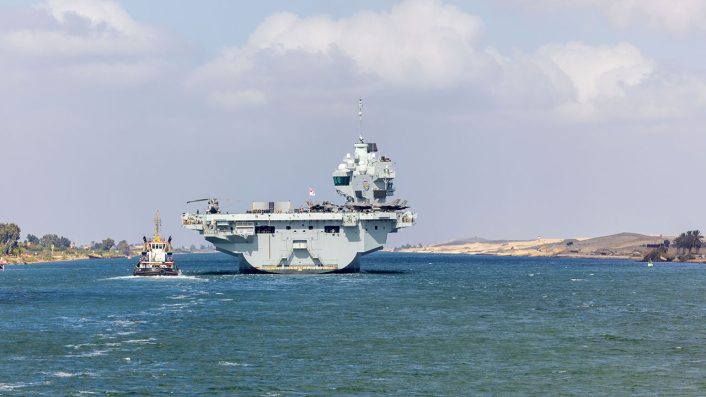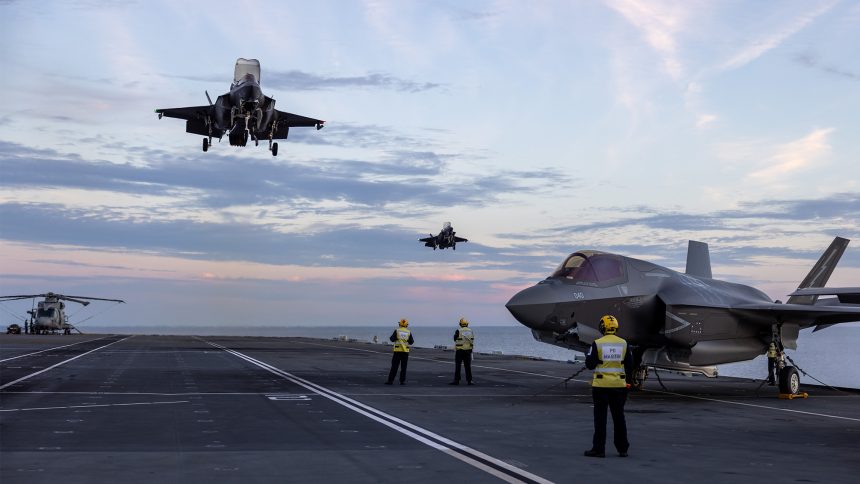Additional F-35Bs have joined the carrier as it sails through the Mediterranean on the tail end of the CSG 25 deployment, satisfying a major requirement for the declaration of full operating capability.
HMS Prince of Wales is now sailing with the largest air wing hosted on a British carrier in decades, exceeding even the U.S. Marine Corps-augmented air wing that deployed on HMS Queen Elizabeth in 2021. Six F-35Bs departed RAF Marham over the last week to head south and augment the 18 jets that have been deployed on the carrier through the bulk of its deployment to the Indo-Pacific.
The 24 aircraft deployed come from both 617 Squadron and 809 Naval Air Squadron – the UK’s two frontline F-35B units – as well as 207 Squadron. With 24 jets now on board this allows the usual practice of having 12 jets per squadron. 207 Squadron, the F-35B Operational Conversion Unit (OCU) have continued their own flight operations from Marham even while a significant portion of the fleet and some of the squadron’s personnel are away from home augmenting the frontline units.
Jets, jets and more jets… 🇬🇧⚡️
The largest number of UK F-35B Lightning jets ever assembled on either of the #RoyalNavy’s new aircraft carriers has been deployed to the Mediterranean for a major allied exercise with @HMSPWLS.#CSG25
Read more: https://t.co/ubeGf3t2Pb pic.twitter.com/xLaFPTMn7d
— Royal Navy (@RoyalNavy) November 6, 2025
While being back in the Mediterranean means that the Carrier Strike Group 25 deployment is soon drawing to a close, the carrier still has a full schedule. Through until Nov. 14, the carrier strike group (CSG) is taking part in Exercise Falcon Strike 25. This Italian-hosted exercise sees fourth and fifth generation fighter aircraft team up to fly complex missions in simulated contested air environments. Originally taking place in 2021 to improve cooperation between U.S. and European F-35 units, 2025’s edition is the first to include five nations – Italy, the U.S., the UK, France, and Greece.
“It is fantastic to be back in the Mediterranean after a hugely successful period in the Indo-Pacific and a transit of the Red Sea. The upcoming exercises with NATO allies will be a real demonstration of the warfighting readiness of the UK Carrier Strike Group,” said Commodore James Blackmore, Commander of the Carrier Strike Group. “The eight-month deployment covers over 26,000 nautical miles and engages with 40 nations, reinforcing the UK’s position as a leading European power delivering fifth-generation aircraft and carrier capabilities assigned as a primary contribution to NATO.”

While 24 jets was set as the minimum necessary to satisfy the requirements of a full operating capability (FOC) declaration, the carrier can theoretically accommodate a greater number – the exact amount depending on the number of helicopters and stores also carried. The large size of the Queen Elizabeth class was primarily influenced by a desire to vastly improve sortie generation rates and simplify deck handling procedures compared to the preceding Invincible class.
This step forward towards FOC is welcome news for the UK’s carrier strike capability, though it still comes at a time when the concept faces several major hurdles. The UK’s Public Accounts Committee recently released its report on the UK F-35 programme, with a number of strong critiques that target the force’s lack of standoff weapons – something which we have covered previously – as well as the slow pace of improvement works at RAF Marham, the added burden of the incoming F-35As and nuclear mission, and overall short-term decision making.
“If [the F-35] is to be wielded in the manner in which it deserves, the MoD must root out the short-termism, complacency and miscalculation in the programme identified in our report.” – @Clifton_BrownG
We’ve published a new report, read more 👇https://t.co/UXb9aLn0ds pic.twitter.com/H1VgWQjXR1
— Public Accounts Committee (@CommonsPAC) October 31, 2025
By the time of the next scheduled carrier deployment to the Indo-Pacific, penciled in for 2029, the Ministry of Defence hopes that its F-35B air wing will be bolstered with the addition of unmanned collaborative combat aircraft (CCA). First Sea Lord General Sir Gwyn Jenkins claimed at DSEI 2025 that he intends to see a CCA concept aircraft launch from one of the carriers by the end of 2026.
In the long term there is still the prospect of a major refit which would see the Queen Elizabeth class equipped with an as-yet unconfirmed combination of catapults and/or arresting wires. These would unlikely be the full scale examples seen on full-CATOBAR carriers like the Gerald R. Ford class, but smaller systems that would allow for lighter types, like drones, to be deployed. Deploying CCAs without these modifications would still be possible, though it is likely to limit the options available.
Project Ark Royal – Plans for angled decks and drones – As part of Project Ark Royal, significant upgrades to the Queen Elizabeth-class aircraft carriers could be undertaken.https://t.co/HJMVLbRD9C
— UK Defence Journal (@UKDefJournal) March 24, 2024
As well as a hybrid manned-unmanned air wing, the Royal Navy hopes to see its ships operate side by side with unmanned surface and sub-surface vessels by the time of the 2029 deployment. In all cases, this is envisoned as a way to increase the force’s combat mass while not exacerbating current personnel shortages or funding gaps.









